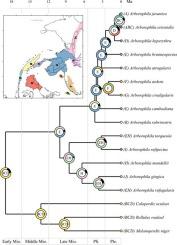Molecular Phylogenetics and Evolution ( IF 3.6 ) Pub Date : 2020-06-18 , DOI: 10.1016/j.ympev.2020.106895 De Chen , Yang Liu , Geoffrey Davison , Ding Li Yong , Shenghan Gao , Junhua Hu , Shou-Hsien Li , Zhengwang Zhang

|
The advent of the phylogenomic era has significantly improved our understanding of the evolutionary history and biogeography of Southeast Asia’s diverse avian fauna. However, the taxonomy and phylogenetic relationships of many Southeast Asian birds remain poorly resolved, especially for those with large geographic ranges, which might have experienced both ancient and recent geological and environmental changes. In this study, we examined the evolutionary history and biogeography of the hill partridges (Galliformes: Phasianidae: Arborophila spp.), currently the second most speciose galliform genus, and thought to have colonized Southeast Asia from Africa. We present a well‐resolved phylogeny of 14 Arborophila species inferred from ultra-conserved elements, exons, and mitochondrial genomes from both fresh and museum samples, which representing almost complete coverage of the genus. Our fossil-calibrated divergence time estimates and biogeographic modeling showed the ancestor of Arborophila arrived in Indochina during the early Miocene, but the initial divergence within Arborophila did not occur until ~10 Ma when global cooling intensified. Subsequent dispersal and diversification within Arborophila were driven by several tectonic and climatic events. In particular, we found evidence of rapid radiation in Indochinese Arborophila during the Pliocene global cooling and extensive dispersal and speciation of Sundaic Arborophila during the Pleistocene sea-level fluctuations. Taken together, these results suggest that the evolutionary history and biogeography of Arborophila were influenced by complex interactions among historical, geological and climatic events in Southeast Asia.
中文翻译:

从低覆盖散弹枪序列中解开山part(Ph科(Phasianidae,Arborophila))的进化历史和生物地理学。
系统生物学时代的到来极大地提高了我们对东南亚不同鸟类动物群的进化历史和生物地理学的理解。但是,许多东南亚鸟类的分类学和系统发育关系仍然难以解决,特别是对于那些地理范围较大的鸟类,这些鸟类可能经历了古代和近期的地质和环境变化。在这项研究中,我们研究了山part(Galliformes:Phasianidae:Arborophila spp。)的进化历史和生物地理学,该山currently目前是第二种最特殊的鸡形目属,并且被认为是从非洲定居东南亚的。我们提出了一个很好解决的14 Arborophila的系统发育从新鲜样本和博物馆样本中的超保守元素,外显子和线粒体基因组推断出的物种,几乎涵盖了该属。我们的化石校准发散时间估计和生物地理模型表明,中新世早期,阿波罗的祖先到达印度支那,但是直到全球冷却加剧时,直到约10 Ma才开始发生阿波罗内部的最初发散。随后,在几个构造和气候事件的驱使下,果树内的扩散和多样化。特别是,我们发现在印度支那的快速辐射的证据山鹧鸪属Sundaic的上新世全球变冷和广泛的传播和形态在山鹧鸪属在更新世海平面波动期间。总之,这些结果表明,进化历史和生物地理学山鹧鸪属被东南亚的历史,地质和气候事件之间复杂的相互作用影响。











































 京公网安备 11010802027423号
京公网安备 11010802027423号